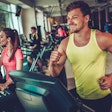Appropriate physical activity often helps to reduce pain for people with arthritis.
Many people with arthritis are re-evaluating their pain medications since the recall of rofecoxib (Vioxx). This drug was being tested to see if it helps to prevent colon polyps (it does) when researchers discovered that people taking Vioxx had a slightly higher risk of heart attack and stroke. Merck voluntarily withdrew the drug from the market.
Other studies have found similar risks with related drugs, including celecoxib (Celebrex) and valdecoxib (Bextra). Like Vioxx, Celebrex and Bextra were developed as painkillers for people who found that other drugs, such as aspirin and ibuprofen, led to gastrointestinal side-effects, such as ulcers. Vioxx, Celebrex and Bextra were marketed heavily to both doctors and consumers as safe alternatives to traditional pain medications. While Celebrex and Bextra remain on the market, their pharmaceutical companies have reduced their advertising, and physicians are urging their patients to take lower doses of these drugs, and to explore alternatives.
Researchers and physicians are discussing these recent findings, and are working hard to come up with guidelines to help define which medications are best for which patients. This is difficult, since only some studies have found increased risks of dangerous side-effects. In other words, it is not clear how risky these medications really are, and, if they are risky, at what dosages. Even over-the-counter drugs such as naproxen (Aleve) appear to carry some risk. In the meantime, people who rely on pain medication are feeling frustrated and confused. Many people, including those with arthritis and fibromyalgia, use quite of bit of pain medication, and take these medications for years.
Can physical activity reduce the need for pain medication?
Many studies have looked at the effects of exercise on many variables for people with arthritis, including levels of pain. In general, appropriate physical activity, including physical therapy, walking, stretching and strength training, often helps to reduce pain for people with arthritis. Here are some things to consider if you are working with clients who have arthritis:
Learn about your client's arthritis. There are several different types of arthritis. A good source for learning about exercise and arthritis is the book by Nelson et al., listed at the end of this column. Another good source is the Arthritis Foundation's website, also listed in the references.
Understand your client's limitations. Work with your client's doctor and physical therapist to learn about his or her physical limitations. If you are uncomfortable working with particular clients because you are not sure of your qualification to do so, refer them to someone else, or back to their healthcare providers.
Help clients feel safe. As always, your exercise recommendations must be tailored to each individual's ability. Discuss your exercise recommendations with your clients. Clients with arthritis often fear injury. They want to know they are safe. Emphasize safety, and reassure them with your knowledge. Start slowly and build gradually to avoid injury.
Talk with clients about exercise adherence. If healthy people have difficulty sticking to an exercise program, you can imagine the additional challenges faced by people coping with physical limitations and pain. Help clients design a strategy for sticking to their exercise programs.
REFERENCES
Arthritis Foundation. www.arthritis.org.
Brosseau, L., L. Pelland, G. Wells, et al. Efficacy of aerobic exercise for osteoarthritis (part II): A meta-analysis. Physical Therapy Reviews9 (3): 125-146.
Nelson, M.E., K.R. Baker, R. Roubenoff and L. Lindner. Strong Women and Men Beat Arthritis. Penguin Putman: New York, N.Y., 2002.
Pelland, L., L. Brosseau, G. Wells, et al. Efficacy of strengthening exercises for osteoarthritis (part I): A meta-analysis. Physical Therapy Reviews 9 (2): 77-108.




































